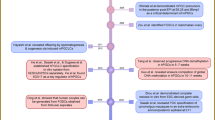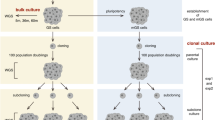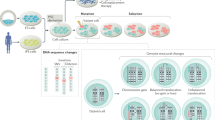Abstract
Arising from: S. Conrad et al. Nature 456, 344–349 (2008)10.1038/nature07404; Conrad et al. reply
Conrad et al. have generated human adult germline stem cells (haGSCs) from human testicular tissue, which they claim have similar pluripotent properties to human embryonic stem cells (hESCs)1. Here we investigate the pluripotency of haGSCs by using global gene-expression analysis based on their gene array data1 and comparing the expression of pluripotency marker genes in haGSCs and hESCs, and in haGSCs and human fibroblast samples derived from different laboratories, including our own. We find that haGSCs and fibroblasts have a similar gene-expression profile, but that haGSCs and hESCs do not. The pluripotency of Conrad and colleagues’ haGSCs is therefore called into question.
Similar content being viewed by others
Main
Fibroblasts can be easily established from human testicular cultures2. Considering the similarities between haGSCs and non-testis fibroblasts, we isolated fibroblasts from human testicular biopsies and derived clusters of cells (human testicular fibroblast cells, hTFCs) from them (Fig. 1a, b). haGSCs were found to be morphologically similar, if not identical, to these hTFCs but not to hESCs (Fig. 1c).
a–c, Phase-contrast images of human testicular fibroblast cells (hTFCs) at high (a) and low (b) magnification and of human embryonic stem cells (hESCs) (line H1) (c); scale bars, 200 μm. d–f, Scatter plots of pairwise global gene-expression comparisons: hESCs versus human adult germline stem cells (haGSCs) (d); hESCs versus hTFCs (e); and haGSCs versus hTFCs (f). g, Real-time RT–PCR analysis of hESCs and hTFCs; error bars represent standard deviation. h, Western blot analysis of OCT4, NANOG and α-TUBULIN. i, Heat map of the microarray gene-expression data of the genes discussed by Conrad et al.1. j, Principal component (PC) analysis of the global gene-expression profiles of hESCs, haGSCs, hTFCs and fibroblasts. k, Heat map of microarray gene expression of a list of human ESC- and fibroblast-enriched genes3. Gene-expression colour key is shown at the top in log2 scale. Microarray data were downloaded from the GEO database; accession numbers GSE11350 (haGSCs, hESCs (ES line H1), human spermatogonial cells (hSCs))1, GSE12583 (foreskin fibroblasts (FF))8, GSE15322 (normal colon fibroblasts (FC)), GSE15148 (ES lines H1L, H7, H9, H13B and H14A, and parental foreskin cells (FP))3 and GSE10831 (B cells)9.
We confirmed this similarity by comparing the global gene-expression profile of hTFCs and haGSCs using the gene array data of Conrad et al.1. Scatter plots reveal that haGSCs were remarkably similar to hTFCs and to previously described fibroblasts, but not to hESCs (Fig. 1d–f). Conrad et al. did not present a scatter plot analysis, which would have helped visualization of any differences between haGSCs and hESCs.
The pluripotency marker genes POU5F1/OCT4, SOX2, NANOG and LIN28, which are expressed in hESCs, were not expressed in haGSCs or in hTFCs, whereas the fibroblast marker genes SNAI2 and ACTA2 (refs 3, 4) were markedly overexpressed. Real-time analysis using polymerase chain reaction with reverse transcription (RT–PCR) confirmed the absence of OCT4, SOX2 and NANOG expression in hTFCs (Fig. 1g).
Messenger RNA expression of OCT4 and NANOG in hTFCs correlated with protein abundance, as determined by western blotting (Fig. 1h). By contrast, the western blot results of Conrad et al.1 indicate that the amounts of OCT4 and NANOG protein in their haGSCs were virtually identical to those in hESCs. However, OCT4 and NANOG mRNA levels, extracted from their microarray data1, were as low in haGSCs as in hTFCs and other human fibroblasts.
This inconsistency between mRNA and protein levels in haGSCs—whether analysed by western blot or immunohistochemistry—was also evident for other genes, such as CDH1/E-cadherin, DAZL and DDX4/VASA (Fig. 1i). Conrad et al. show that STAT3 and CDH2/N-cadherin are highly expressed in haGSCs, consistent with our findings (Fig. 1i). However, expression of STAT3 and CDH2/N-cadherin in human ESCs was nearly identical to that in human fibroblasts (Fig. 1i). Therefore, the expression of these genes cannot be used to distinguish pluripotent cells from fibroblasts.
Principal component analysis of global gene-expression data revealed that haGSCs clustered closely with hTFCs and with previously described human fibroblasts, but not with hESCs (Fig. 1j). Heat-map analysis with pluripotent and fibroblastic genes3 showed that haGSCs were fibroblastic, but not pluripotent, in their gene-expression profile (Fig. 1k).
Our results indicate that haGSCs are by no means similar to hESCs but that they do strongly resemble our hTFCs, which are not pluripotent. These findings are at odds with those of Conrad et al.1, who report that their haGSCs are able to form teratomas, a defining feature of human pluripotent cells.
Methods Summary
hTFCs were obtained from routine biopsies taken during testicular surgery (with patients’ informed written consent). Following mechanical tissue disruption and enzymatic digestion, cells were cultured in the medium described by Conrad et al.1. These experiments were approved by the local ethics council. Microarray analysis in hTFCs was performed using Human Genome U133 Plus 2.0 chip (Affymetrix) and processed as in ref. 5. The array data were deposited in the Gene Expression Omnibus (GEO) database (accession number GSE17772). All microarrays used in this study were globally normalized with the RMA algorithm implemented in R-Bioconductor6.
Authors’ note: We contacted Conrad et al. to obtain their haGSC lines1; however, the established haGSCs are not accessible at present to other laboratories because consent between Conrad et al. and donor patients did not include permission to distribute cells derived from the biopsies7. At the start of 2009, T. Skutella agreed to send us the haGSCs once he receives permission for their distribution, but we have not so far received them. We have been informed that the original consent form stipulates that all derived cell lines must be destroyed after a period of three years following biopsy.
References
Conrad, S. et al. Generation of pluripotent stem cells from adult human testis. Nature 456, 344–349 (2008)
Chen, A. T., Fu, Y. S. & Reidy, J. A. Human testicular cultures. II. Sertoli cells. In Vitro 11, 313–321 (1975)
Yu, J. et al. Human induced pluripotent stem cells free of vector and transgene sequences. Science 324, 797–801 (2009)
Nakagawa, H. et al. Role of cancer-associated stromal fibroblasts in metastatic colon cancer to the liver and their expression profiles. Oncogene 23, 7366–7377 (2004)
Ko, K. et al. Induction of pluripotency in adult unipotent germline stem cells. Cell Stem Cell 5, 87–96 (2009)
Irizarry, R. A. et al. Summaries of Affymetrix GeneChip probe level data. Nucleic Acids Res. 31, e15 (2003)
Conrad, S. et al. Generation of pluripotent stem cells from adult human testis. Nature 460, 1044 (2009)
Aasen, T. et al. Efficient and rapid generation of induced pluripotent stem cells from human keratinocytes. Nature Biotechnol. 26, 1276–1284 (2008)
Vockerodt, M. et al. The Epstein–Barr virus oncoprotein, latent membrane protein-1, reprograms germinal centre B cells towards a Hodgkin's Reed–Sternberg-like phenotype. J. Pathol. 216, 83–92 (2008)
Author information
Authors and Affiliations
Corresponding author
Ethics declarations
Competing interests
The authors declare no competing financial interests.
PowerPoint slides
Rights and permissions
About this article
Cite this article
Ko, K., Araúzo-Bravo, M., Tapia, N. et al. Human adult germline stem cells in question. Nature 465, E1 (2010). https://doi.org/10.1038/nature09089
Received:
Accepted:
Issue Date:
DOI: https://doi.org/10.1038/nature09089
This article is cited by
-
Previously claimed male germline stem cells from porcine testis are actually progenitor Leydig cells
Stem Cell Research & Therapy (2018)
-
Dynamic stem cell states: naive to primed pluripotency in rodents and humans
Nature Reviews Molecular Cell Biology (2016)
-
Hallmarks of pluripotency
Nature (2015)
-
Endometrial stem cells in regenerative medicine
Journal of Biological Engineering (2014)
-
Retraction Note: Generation of pluripotent stem cells from adult human testis
Nature (2014)
Comments
By submitting a comment you agree to abide by our Terms and Community Guidelines. If you find something abusive or that does not comply with our terms or guidelines please flag it as inappropriate.




